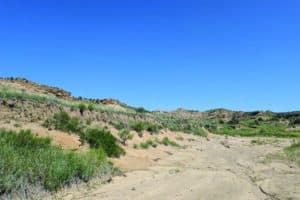Yesteryear
Coben Scott is a history graduate, a history buff, and he has explored and researched much of Falcon and the area’s past. Coben will be writing a column for the NFH on the history of the plains that will be published every other month.
Homestead Ranch Park
By Coben Scott
Today, when one visits Homestead Ranch Park, just north of Peyton, you can expect to see kids on the playground, horses trotting trails and families going on short hikes, but its roots trace back further than imagined.
Stepping back in time to the early 1870s, coming from the East in search of a new life, Stephen and Martha Holden planted their feet just north of modern-day Peyton. In 1873, the two claimed the area now known as Homestead Ranch Park and settled there. They began ranching the land and raising a family of their own.
For an unknown reason (perhaps the death of Stephen), the two sold the ranch in 1897. There is also reason to believe that the Holdens came with family while settling and ranching the land, and moved toward the Bijou Basin after this sale. Regardless of theories, Martha sold the ranch and land to a man by the name of Charles H. Cheese.
The Cheese family came from Illinois west, similar to how Charles’ father came from England west in the early 1800s. The Cheeses would grow not just as a family but also the ranch, amassing a total of 2,160 acres under their care. Charles and his wife, Clara, raised their children on the ranch; eventually, their grandchildren were raised on the ranch. Charles’ son Clarence left the homestead and built his life in Colorado Springs sometime around the early 1900s, joining the Freemasons. The rest of the children stuck around the area, although at some point they collectively changed their names from Cheese to Cleese.
By the 1920s, new technology had reached the land; Charles brought along tractors and even had a telephone wired into their house. Charles’ youngest daughter, Gladys, took over the ranch after her father’s passing in 1930, alongside her new husband, John Person. The two took the ranch in a slightly different direction by raising sheep, rather than cows. The two had three children they raised on the ranch.
Sadly, as time went on, the Cleese-Person Ranch began to shrink. With Gladys and John’s children living their own lives and no one to take over the ranch, the two decided it would be best to sell the 380 acres they had left in 1986. Thankfully for us fine folks on the prairie, the beauty of the ranch was bought and preserved by El Paso County Parks and Recreation, with the intent of one day transforming the land into what it is today.
As for the Persons, the two lived the rest of their days next to the ranch they once lived in, Gladys died in 1990, and John in 91. Their children passed only recently, in 2015, 16, and 20. Gladys and her parents, as well as John and their daughter Alberta are all buried in the Peyton cemetery.
Regarding the park, development began in the early 2000s. In 2004, the bulk of development occurred, with the installation of bathrooms and the construction of trails and parking. In 2005, the fishing lake was added; in 2007, there were pavilions and a playground. In 2014, a new trail loop was added. The park is a source of pride for the county, along with the Paint Mines and Fox Run.
While hiking the areas, I have particularly noticed off-trail old campfires and rusted bean cans shot up from what I can imagine of the old days. I recommend this park to anyone who has an interest in the outdoors and wants something closer and smaller than the Paint Mines of Calhan. It’s great for all ages. The area is dog and horse friendly, and it’s a spot for both bird and bat watchers. The trails are scenic and easy; the lake is a hotspot for the mild fisherman. It’s a sanctuary for local wildlife; and, most importantly, it’s in Falcon’s backyard.




